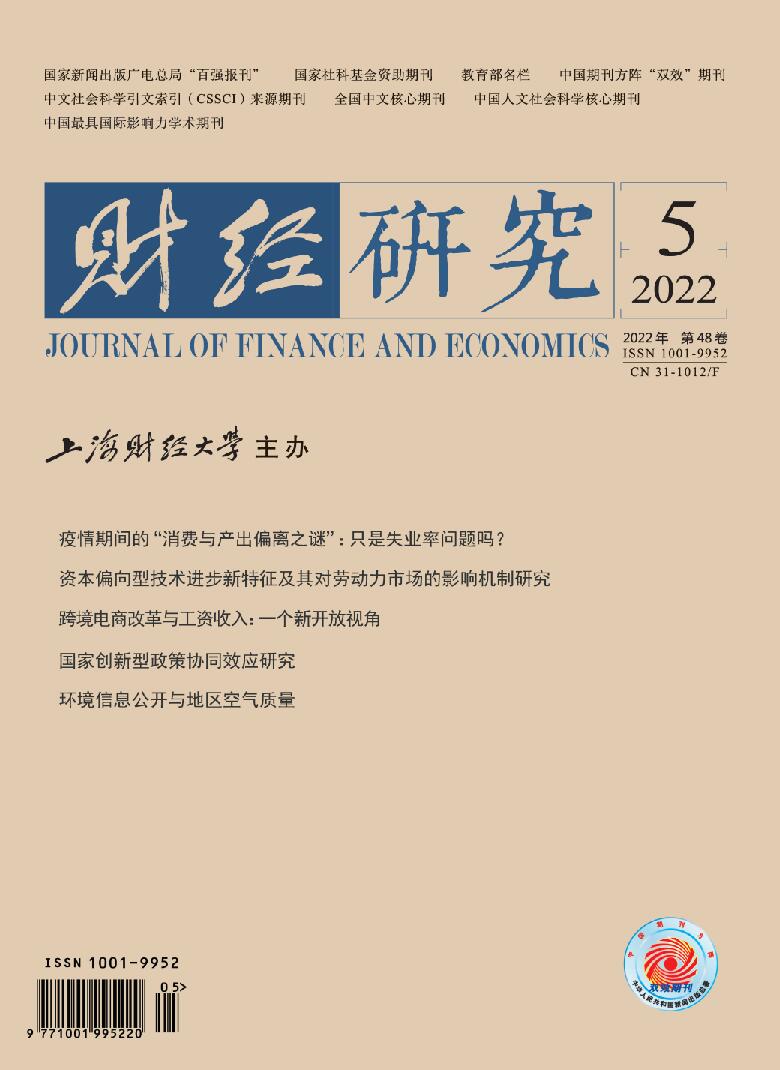新冠疫情期间出现了消费偏离产出轨道的反常现象,表现出超速下降和恢复迟缓的特征。文章为了探讨该谜题背后的经济原因,通过构建一个动态随机一般均衡模型,对这种现象进行了深入探讨,发现家庭收入不确定性增加和就业质量下降导致的劳动力市场资源错配是产生这一现象的重要原因,单纯的失业率上升仅会起到触发作用。其中,劳动力市场资源错配问题将会造成长期影响。同时,文章也发现疫情对于大企业和中小企业就业人员的影响具有很强的异质性。具体而言,由于大企业员工受到的失业风险和收入不确定性较小,因此疫情主要通过社会平均工资来影响退休后的收入。但对于中小企业员工而言,由于劳动力市场的疲软导致的收入结构性变化具有累积作用,这就导致中年群体受到疫情的影响最大。因此根据文章的结论,保就业不能仅仅围绕就业数量,还要稳住就业质量不下降,保证劳动力市场供需匹配,尽可能避免劳动力市场资源错配带来的家庭永久性收入损失和对中国经济运行产生的长期效应。另外,中小企业就业者和青年群体受到的消费负面影响最大,他们受到的就业冲击最大,应保障其就业与收入。文章的研究结论对当前中国制定更加精准、可持续的稳就业和促消费政策具有一定的参考价值。
疫情期间的“消费与产出偏离之谜”:只是失业率问题吗?
摘要
参考文献
摘要
关键词
7 肖兴志, 张伟广, 朝镛. 僵尸企业与就业增长: 保护还是排挤?[J]. 管理世界,2019,(8):69−83. DOI:10.3969/j.issn.1002-5502.2019.08.006
10 Aguiar M, Gopinath G. Emerging market business cycles: The cycle is the trend[J]. Journal of Political Economy,2007,115(1): 69−102. DOI:10.1086/511283
11 Auerbach A J, Kotlikoff L J. Dynamic fiscal policy[M]. Cambridge: Cambridge University Press, 1987.
12 Bai C E, Hsieh C T, Qian Y Y. The return to capital in China[J]. Brookings Papers on Economic Activity,2006,37(2): 61−101.
13 Baker S R, Farrokhnia R A, Meyer S, et al. How does household spending respond to an epidemic? Consumption during the 2020 COVID-19 Pandemic[R]. NBER Working Paper No. 26949, 2020.
14 Barnichon R, Zylberberg Y. Underemployment and the trickle-down of unemployment[J]. American Economic Journal:Macroeconomics,2019,11(2): 40−78. DOI:10.1257/mac.20160220
15 Bourquin P, Delestre I, Joyce R, et al. The effects of coronavirus on household finances and financial distress[R]. IFS Briefing Note. BN298, 2020.
16 Carvalho V M, Garcia J R, Hansen S, et al. Tracking the COVID-19 crisis with high-resolution transaction data[R]. Cambridge Working Papers in Economics 2030, 2020.
17 Chetty R, Friedman J N, Hendren N, et al. How did COVID-19 and stabilization policies affect spending and employment? A new real-time economic tracker based on private sector data[R]. NBER Working Paper No. 27431, 2020.
18 Coibion O, Gorodnichenko Y, Weber M. The cost of the covid-19 crisis: Lockdowns, macroeconomic expectations, and consumer spending[R]. NBER Working Paper No. 27141, 2020.
19 Conesa J C, Krueger D. Social security reform with heterogeneous agents[J]. Review of Economic Dynamics,1999,2(4): 757−795. DOI:10.1006/redy.1998.0039
20 Cox N, Ganong P, Noel P, et al. Initial impacts of the pandemic on consumer behavior: Evidence from linked income, spending, and savings data[R]. University of Chicago, Becker Friedman Institute for Economics Working Paper No. 2020-82, 2020.
21 Deaton A, Paxson C. Intertemporal choice and inequality[J]. Journal of Political Economy,1994,102(3): 437−467. DOI:10.1086/261941
22 Fujita S. Declining labor turnover and turbulence[J]. Journal of Monetary Economics,2018,99: 1−19. DOI:10.1016/j.jmoneco.2017.12.005
23 He H, Ning L, Zhu D M. The impact of rapid aging and pension reform on savings and the labor supply[R]. International Monetary Fund Working Paper No. 19/61, 2019.
24 Hoke S H, Känzig D R, Surico P. Consumption in the time of COVID-19: Evidence from UK transaction data[R]. CEPR Discussion Paper No. 14733, 2020.
25 Imrohoroglu A, Imrohoroglu S, Joines D H. A life cycle analysis of social security[J]. Economic Theory,1995,6(1): 83−114. DOI:10.1007/BF01213942
26 Marinescu I, Skandalis D. Unemployment insurance and job search behavior[J]. The Quarterly Journal of Economics,2021,136(2): 887−931. DOI:10.1093/qje/qjaa037
27 Ortego-Marti V. Unemployment history and frictional wage dispersion[J]. Journal of Monetary Economics,2016,78: 5−22. DOI:10.1016/j.jmoneco.2015.12.002
28 Palmon O, Sun H L, Tang A P. Layoff announcements: Stock market impact and financial performance[J]. Financial Management,1997,26(3): 54−68. DOI:10.2307/3666213
29 Schmieder J F, Von Wachter T, Bender S. The effect of unemployment benefits and nonemployment durations on wages[J]. American Economic Review,2016,106(3): 739−777. DOI:10.1257/aer.20141566
30 Tauchen G. Finite state Markov-chain approximations to univariate and vector autoregressions[J]. Economics Letters,1986,20(2): 177−181. DOI:10.1016/0165-1765(86)90168-0
引用本文
刘金东, 宁磊, 姜令臻. 疫情期间的“消费与产出偏离之谜”:只是失业率问题吗?[J]. 财经研究, 2022, 48(5): 4-18.
导出参考文献,格式为:





 5701
5701  8944
8944

